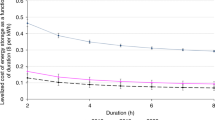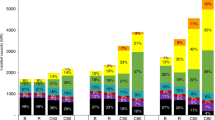Abstract
There has been growing interest in using energy storage to capture solar energy for later use in the home to reduce reliance on the traditional utility. However, few studies have critically assessed the trade-offs associated with storing solar energy rather than sending it to the utility grid, as is typically done today. Here we show that a typical battery system could reduce peak power demand by 8–32% and reduce peak power injections by 5–42%, depending on how it operates. However, storage inefficiencies increase annual energy consumption by 324–591 kWh per household on average. Furthermore, storage operation indirectly increases emissions by 153–303 kg CO2, 0.03–0.20 kg SO2 and 0.04–0.26 kg NOx per Texas household annually. Thus, home energy storage would not automatically reduce emissions or energy consumption unless it directly enables renewable energy.
This is a preview of subscription content, access via your institution
Access options
Access Nature and 54 other Nature Portfolio journals
Get Nature+, our best-value online-access subscription
$29.99 / 30 days
cancel any time
Subscribe to this journal
Receive 12 digital issues and online access to articles
$119.00 per year
only $9.92 per issue
Buy this article
- Purchase on Springer Link
- Instant access to full article PDF
Prices may be subject to local taxes which are calculated during checkout





Similar content being viewed by others
References
Walton, R. Residential Energy Storage: The Industry’s Next Big Thing (UtilityDIVE, 2015); http://www.utilitydive.com/news/residential-energy-storage-the-industrys-next-big-thing/406789
Sonnenbatterie Sonnenbatterie Enters US Market with First Distribution Deal (2014); http://www.sonnenbattery.com/en/press/news/news/article/sonnenbatterie-enters-us-market-with-first-distribution-deal
Tesla Motors Powerwall Tesla Home Battery (2015); https://www.teslamotors.com/powerwall
Green Mountain Power Files First in the Country Innovative Plan to Offer Vermonters the Tesla Powerwall Home Battery (Green Mountain Power, 2015); http://news.greenmountainpower.com/manual-releases/Green-Mountain-Power-Files-First-in-the-Country-In
Sungevity & Sonnenbatterie Sungevity and Sonnenbatterie Announce Partnership to Offer Home Energy Storage (2015); http://www.sungevity.com/article/?Id=a6MU00000004DQLMA2&_ga=1.97172890.465704836.1444095635
Cohen, M. & Callaway, D. Effects of distributed PV generation on California’s distribution system, Part 1: engineering simulations. Sol. Energy 128, 126–138 (2016).
Cohen, M., Kauzmann, P. & Callaway, D. Effects of distributed PV generation on California’s distribution system, part 2: economic analysis. Sol. Energy 128, 139–152 (2016).
Nguyen, D. A. et al. Impact Research of High Photovoltaics Penetration Using High Resolution Resource Assessment with Sky Imager and Power System Simulation (2015); http://calsolarresearch.ca.gov/images/stories/documents/Sol3_funded_proj_docs/UCSD/CSIRDD-Sol3_UCSD_Task4_3_20151121.pdf
Braun, M. et al. Is the distribution grid ready to accept large-scale photovoltaic deployment? State of the art, progress, and future prospects. Prog. Photovolt. Res. Appl. 20, 681–697 (2012).
Smith, J. W., Sunderman, W., Dugan, R. & Seal, B. Smart inverter volt/var control functions for high penetration of PV on distribution systems. In Proceedings of the 2011 IEEE/PES Power Systems Conference and Exposition (PSCE) 1–6 (IEEE, PES, 2011).
Stetz, T., Kraiczy, M., Braun, M. & Schmidt, S. Technical and economical assessment of voltage control strategies in distribution grids. Prog. Photovolt. Res. Appl. 21, 1292–1307 (2013).
Von Appen, J., Braun, M., Stetz, T., Diwold, K. & Geibel, D. Time in the sun: the challenge of high PV penetration in the German electric grid. IEEE Power Energy Mag. 11, 55–64 (2013).
Büchner, J. et al. Smart grids in Germany: how much costs do distribution grids cause at planning time? In Proceedings of the 2015 International Symposium on Smart Electric Distribution Systems and Technologies (EDST) 224–229 (EDST, 2015).
Stetz, T. et al. Techno-economic assessment of voltage control strategies in low voltage grids. IEEE Trans. Smart Grid 5, 2125–2132 (2014).
Castillo-Cagigal, M. et al. PV self-consumption optimization with storage and Active DSM for the residential sector. Sol. Energy 85, 2338–2348 (2011).
Braun, M., Büdenbender, K., Magnor, D. & Jossen, A. Photovoltaic self-consumption in Germany—using lithium-ion storage to increase self-consumed photovoltaic energy. In Proceedings of the 24th European Photovoltaic Solar Energy Conference 2009 3121–3127 (Fraunhofer ISE, 2009).
Mulder, G., Ridder, F. D. & Six, D. Electricity storage for grid-connected household dwellings with PV panels. Sol. Energy 84, 1284–1293 (2010).
Lang, T., Ammann, D. & Girod, B. Profitability in absence of subsidies: a techno-economic analysis of rooftop photovoltaic self-consumption in residential and commercial buildings. Renew. Energy 87, 77–87 (2016).
Hoppmann, J., Volland, J., Schmidt, T. S. & Hoffmann, V. H. The economic viability of battery storage for residential solar photovoltaic systems—a review and a simulation model. Renew. Sustain. Energy Rev. 39, 1101–1118 (2014).
Resch, M., Ramadhani, B., Bühler, J. & Sumper, A. Comparison of control strategies of residential PV storage systems. In Proceedings of the 9th International Renewable Energy Storage Conference (Elsevier Procedia, 2015).
Santos, J. M., Moura, P. S. & de Almeida, A. T. Technical and economic impact of residential electricity storage at local and grid level for Portugal. Appl. Energy 128, 254–264 (2014).
How It Works (Power Station 247, 2016); http://www.powerstation247.com/how-it-works/storing-solar-energy-with-your-powerstation.html
von Appen, J., Braslavsky, J. H., Ward, J. K. & Braun, M. Sizing and grid impact of PV battery systems—a comparative analysis for Australia and Germany. In 2015 Int. Symp. Smart Electric Distribution Systems and Technologies (EDST) 612–619 (IEEE, 2015); http://ieeexplore.ieee.org/lpdocs/epic03/wrapper.htm?arnumber=7315280
Moshövel, J. et al. Analysis of the maximal possible grid relief from PV-peak-power impacts by using storage systems for increased self-consumption. Appl. Energy 137, 567–575 (2015).
McKenna, E., McManus, M., Cooper, S. & Thomson, M. Economic and environmental impact of lead-acid batteries in grid-connected domestic PV systems. Appl. Energy 104, 239–249 (2013).
Pecan Street Incorporated Pecan Street Dataport (2015); https://dataport.pecanstreet.org
Austin Energy Residential Solar Energy Rate—Value of Solar (2016); http://austinenergy.com/wps/portal/ae/rates/residential-rates/residential-solar-energy-rate
Austin Energy City of Austin Electric Tariff (2016); http://austinenergy.com/wps/wcm/connect/ab6d045c-643e-4c16-921f-c76fa0fee2bf/FY2016aeElectricRateSchedule.pdf?MOD=AJPERES
CPS Energy Solar Billing Facts (2016); https://www.cpsenergy.com/content/dam/corporate/en/Documents/EnergyEfficiency/solar_billing_facts.pdf
CPS Energy Residential Service Electric Rate (2016); https://www.cpsenergy.com/content/dam/corporate/en/Documents/Rate_ResidentialElectric.pdf
MP2 Energy 12-Month Solar Net Metering Offer for Customers (2015); https://www.mp2energy.com/pdf/12 MONTH EFL_RESI_NEM_SCTY_093015.pdf
MP2 Energy 24-Month Solar Net Metering Offer for Customers (2015); https://www.mp2energy.com/pdf/24 MONTH EFL_RESI_NEM_SCTY_093015.pdf
Public Utility Commission of Texas Summary of Current Commission-Approved Charges for ERCOT TDUs (2016); https://www.puc.texas.gov/industry/electric/rates/Trans/TDArchive/TDGenericRateSummary_030116.pdf
MP2 Energy Solar Buyback—24 Month (2015); https://www.mp2energy.com/pdf/NEB_EFL_Oct 2015_60 mos_FINAL.pdf
TXU Energy TXU Energy Clean Energy Credit Program for Surplus Distributed Renewable Generation (2015); https://www.txu.com/savings-solutions/renewable-energy/renewable-buyback.aspx
TXU Energy TXU Energy Simple Rate 12—Oncor Service Area (2016); https://www.txu.com/Handlers/PDFGenerator.ashx?comProdId=ONXSIMRTND12AE&lang=en&formType=EnergyFactsLabel&custClass=3&tdsp=ONCOR
TXU Energy TXU Energy Simple Rate 12—CenterPoint Energy Service Area (2016); https://www.txu.com/Handlers/PDFGenerator.ashx?comProdId=CPXSIMRTND12AG&lang=en&formType=Disclaimer&custClass=3&tdsp=CENTERP
Hawaiian Electric Company Customer Grid Supply and Self Supply Programs (2016); https://www.hawaiianelectric.com/clean-energy-hawaii/producing-clean-energy/customer-grid-supply-and-self-supply-programs
Hawaiian Electric Company HECO Hawaii and Oahu Electric Rate Schedule R—Residential Service (2016); https://www.hawaiianelectric.com/Documents/my_account/rates/hawaiian_electric_rates/heco_rates_sch_r.pdf
Hawaiian Electric Company HECO Maui Electric Rate Schedule R—Residential Service (2016); https://www.hawaiianelectric.com/Documents/my_account/rates/maui_electric_rates_maui/maui_rates_sch_r.pdf
Hawaiian Electric Company HECO Molokai Electric Rate Schedule R—Residential Service (2016); https://www.hawaiianelectric.com/Documents/my_account/rates/maui_electric_rates_molokai/molokai_rates_sch_r.pdf
Hawaiian Electric Company HECO Lanai Electric Rate Schedule R—Residential Service (2016); https://www.hawaiianelectric.com/Documents/my_account/rates/maui_electric_rates_lanai/lanai_rates_sch_r.pdf
Pacific Gas and Electric Understand Net Energy Metering (NEM) and Your Bill (2016); http://www.pge.com/en/myhome/saveenergymoney/solar/nembill.page?WT.mc_id=Vanity_nem
Pacific Gas and Electric Residential Electric Rates (2016); http://www.pge.com/tariffs/electric.shtml#RESELEC
San Diego Gas and Electric Net Energy Metering Program (2016); http://www.sdge.com/clean-energy/overview/overview
San Diego Gas and Electric Schedule DR—Residential Service (2016); https://www.sdge.com/sites/default/files/regulatory/1-1-16 Schedule DR Total Rates Table.pdf
Southern California Edison Net Energy Metering (2016); https://www.sce.com/NEM
Southern California Edison Schedule D—Domestic Service (2016); https://www.sce.com/NR/sc3/tm2/pdf/ce12-12.pdf
Akhil, A. A. et al. DOE/EPRI 2013 Electricity Storage Handbook in Collaboration with NRECA Tech. Rep. (Sandia National Laboratories, 2013).
Randall, T. Tesla’s New Battery Doesn’t Work That Well With Solar (2015); http://www.bloomberg.com/news/articles/2015-05-06/tesla-s-new-battery-doesn-t-work-that-well-with-solar
Siler-Evans, K., Azevedo, I. L. & Morgan, M. G. Marginal emissions factors for the U.S. electricity system. Environ. Sci. Technol. 46, 4742–4748 (2012).
Siler-Evans, K., Azevedo, I. M. L. & Morgan, M. G. Marginal Emissions Factors Repository (2012); http://cedmcenter.org/tools-for-cedm/marginal-emissions-factors-repository
U.S. Environmental Protection Agency Regional Data Files for 2014—Texas (2014); https://www.epa.gov/statelocalclimate/download-avert
Willis, H. L. Power Distribution Planning Reference Book 2nd edn (Marcel Dekker, 2004).
Eyer, J. & Corey, G. Energy Storage for the Electricity Grid: Benefits and Market Potential Assessment Guide A Study for the DOE Energy Storage Systems Program Tech. Rep. (Sandia National Laboratories, 2010).
Khalilpour, R. & Vassallo, A. Leaving the grid: an ambition or a real choice? Energy Policy 82, 207–221 (2015).
Kind, P. Disruptive Challenges: Financial Implications and Strategic Responses to a Changing Retail Electric Business Tech. Rep. (Edison Electric Institute, 2013); http://www.eei.org/ourissues/finance/documents/disruptivechallenges.pdf
Hittinger, E. S. & Azevedo, I. M. L. Bulk energy storage increases United States electricity system emissions. Environ. Sci. Technol. 49, 3203–3210 (2015).
Public Utilities Commission of Hawaii Distributed Energy Resources (Docket No. 2014-0192) (2015); http://puc.hawaii.gov/wp-content/uploads/2015/10/DER-Phase-1-DO-Summary.pdf
Rhodes, J. D. et al. Experimental and data collection methods for a large-scale smart grid deployment: methods and first results. Energy 65, 462–471 (2014).
Gyuk, I. & Eckroad, S. EPRI-DOE Handbook of Energy Storage for Transmission and Distribution Applications Tech. Rep. (EPRI-DOE, 2003).
Ideal Power Ideal Power 30 kW Battery Converter Specification (2015); http://www.idealpower.com/products
Hittinger, E., Whitacre, J. F. & Apt, J. What properties of grid energy storage are most valuable? J. Power Sources 206, 436–449 (2012).
General Algebraic Modeling System (GAMS) Release 24.2.1 (GAMS Development Corporation, 2013); http://www.gams.com
Wächter, A. & Biegler, L. T. On the implementation of an interior-point filter line-search algorithm for large-scale nonlinear programming. Math. Program. 106, 25–57 (2006).
Jain, R. & Dirkse, S. gdxrrw: An Interface between GAMS and R (2014); https://support.gams.com/gdxrrw:interfacing_gams_and_r
R Core Team R: A Language and Environment for Statistical Computing (R Foundation for Statistical Computing, 2015); https://www.r-project.org
Schoenung, S. M. & Eyer, J. Benefit/Cost Framework for Evaluating Modular Energy Storage Tech. Rep. (Sandia National Laboratories, 2008); http://prod.sandia.gov/techlib/access-control.cgi/2008/080978.pdf
U.S. Environmental Protection Agency Air Markets Program Data (2016); https://ampd.epa.gov/ampd
Acknowledgements
This work was sponsored by Pecan Street, the Electric Reliability Council of Texas (ERCOT), and the University of Texas Energy Institute. Special thanks to R. Baldick for his questions, which helped shape this work.
Author information
Authors and Affiliations
Contributions
R.L.F. identified the research question, curated the data used, designed the research methods, analysed the numerical results, and prepared the manuscript. M.E.W. contributed to identifying the research question, interpreted the results, prepared the manuscript, and provided institutional and material support for the research.
Corresponding author
Ethics declarations
Competing interests
This work was sponsored in part by the University of Texas Energy Institute, which has a number of internal and external funding sources. External funding sources include oil and gas producers, investor- and publicly owned electric utilities, and environmental non-profits that might be perceived to influence the results and/or discussion reported in this paper. A complete list of Energy Institute sponsors is available online (http://energy.utexas.edu/mission/sponsors-financial-support). Only the authors were directly involved with developing the manuscript.
Supplementary information
Supplementary Information
Supplementary Table 1, Supplementary Figures 1–35, Supplementary Notes 1–2, Supplementary References. (PDF 1283 kb)
Rights and permissions
About this article
Cite this article
Fares, R., Webber, M. The impacts of storing solar energy in the home to reduce reliance on the utility. Nat Energy 2, 17001 (2017). https://doi.org/10.1038/nenergy.2017.1
Received:
Accepted:
Published:
DOI: https://doi.org/10.1038/nenergy.2017.1
This article is cited by
-
Demcrp-et: decentralized multi-criteria ranked prosumers energy trading using distributed ledger technology
Peer-to-Peer Networking and Applications (2024)
-
Improved performances in Sb2Se3 solar cells based on CdS buffered TiO2 electron transport layer
Journal of Sol-Gel Science and Technology (2024)
-
Heterogeneous effects of battery storage deployment strategies on decarbonization of provincial power systems in China
Nature Communications (2023)
-
Synthesis and characterization of metal oxide-based microcapsules including phase change materials for energy storage applications
Journal of Thermal Analysis and Calorimetry (2023)
-
Electrolysis energy efficiency of highly concentrated FeCl2 solutions for power-to-solid energy storage technology
Journal of Solid State Electrochemistry (2022)



